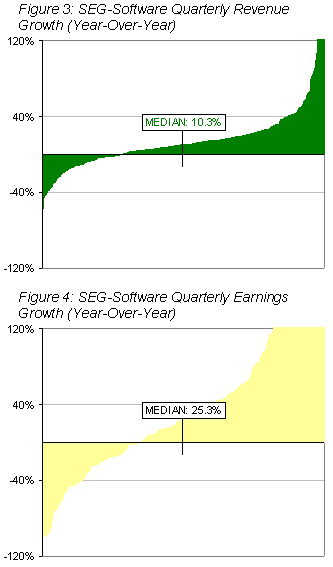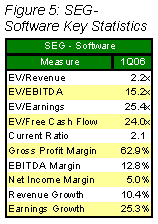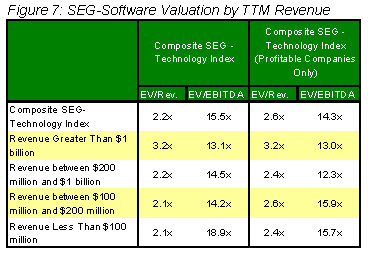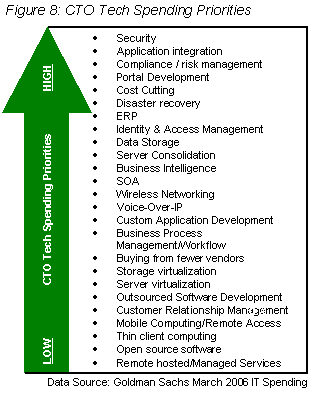|
|
| Home - Software M&A Review - May 06 Issue |
Software M&A – Q1 2006 was The Best Since '99
continued... page 2 |
Public Software Company Performance
 The 262 software companies comprising the new SEG Software Index reported median revenue growth of 10.4% and median earnings growth of 25.3% over the same quarter a year ago (Figure 3 and 4). But despite the software industry's continued improvement in financial performance and a run up in software stock prices toward the close of 2005, median public software company valuations enterprise value to revenue multiples have for all practical purposes flat-lined at 2.2x. However, there were signs of renewed investor interest in software, as the median market cap of SEG Software Index companies closed 1Q06 up 8.2% from the last trading day of 2005 (Figure 2). Other key financial performance measures for the SEG-Software Index are enumerated in Figure 5. The 262 software companies comprising the new SEG Software Index reported median revenue growth of 10.4% and median earnings growth of 25.3% over the same quarter a year ago (Figure 3 and 4). But despite the software industry's continued improvement in financial performance and a run up in software stock prices toward the close of 2005, median public software company valuations enterprise value to revenue multiples have for all practical purposes flat-lined at 2.2x. However, there were signs of renewed investor interest in software, as the median market cap of SEG Software Index companies closed 1Q06 up 8.2% from the last trading day of 2005 (Figure 2). Other key financial performance measures for the SEG-Software Index are enumerated in Figure 5.
As in past quarters, public software company financial performance 1Q06 varied widely by product category (Figure 6). Relative to 1Q05, providers of eCommerce enablement software (Art Technology Group, Cybersource, Immergent, Optimal Group, et. al.) and multimedia, graphics & digital design (Adobe, Avid Technology, Bitstream, InterVideo, Loudeye, et. al.) led all other software categories in 1Q06 revenue growth (+43.5% and +31.9%, respectively), while software companies providing solutions for entertainment (-10.9%), billing & service provisioning (+0.5%) and asset management (+3.2%) continued to lag far behind. As for earnings, vendors of eCommerce enablement software led all other categories, reporting an average 1Q06 earnings increase of 94.3% over 1Q05, while entertainment software companies declined 27.3% in median earnings over the same time period.
 Investors are holding public software companies" feet to the fire as never before, demanding top line growth, particularly from new licenses and/or subscriptions. At the same time, investors are clamoring for sustained, quarter-over-quarter increases in earnings and profitability, with a special emphasis on free cash flow. Public software companies that fail to both grow revenue and generate significant free cash flow and EBITDA returns should see little if any increase in valuation in the coming quarters. Those that exceed expectations can expect to be rewarded. 1Q06 illustrates this well: the median EV/Revenue multiple for SEG Software Index companies posting a profit in 4Q05 was 2.6x, but only 1.4x for those reporting losses. Investors are holding public software companies" feet to the fire as never before, demanding top line growth, particularly from new licenses and/or subscriptions. At the same time, investors are clamoring for sustained, quarter-over-quarter increases in earnings and profitability, with a special emphasis on free cash flow. Public software companies that fail to both grow revenue and generate significant free cash flow and EBITDA returns should see little if any increase in valuation in the coming quarters. Those that exceed expectations can expect to be rewarded. 1Q06 illustrates this well: the median EV/Revenue multiple for SEG Software Index companies posting a profit in 4Q05 was 2.6x, but only 1.4x for those reporting losses.
We've long maintained and frequently demonstrated that size matters when it comes to public company software valuations, and 1Q06 proved no exception. For the quarter, SEG-Software companies with revenues greater than $1 billion posted a median EV/Revenue ratio of 3.2x, compared to a median ratio of 2.2x for software companies with revenue less than $1 billion (Figure 7). The bigger is better valuation truism has become a principal driver of software industry M&A activity.

 IT spending continues to have a direct and significant downstream impact on software company financial performance. According to Goldman Sachs" March IT Spending Survey, IT spending growth for 2006 will be slightly greater than 2005. Specific IT spending priorities for 2006 are enumerated in Figure 8. Security remains the top priority this year, while many of the most talked about technologies and trends, such as virtualization, open source software, server/storage virtualization and hosted software as a service, ranked very low as IT spending priorities. It would seem there's more buzz than budget for these technologies and trends, but there's more here than meets the eye. IT spending continues to have a direct and significant downstream impact on software company financial performance. According to Goldman Sachs" March IT Spending Survey, IT spending growth for 2006 will be slightly greater than 2005. Specific IT spending priorities for 2006 are enumerated in Figure 8. Security remains the top priority this year, while many of the most talked about technologies and trends, such as virtualization, open source software, server/storage virtualization and hosted software as a service, ranked very low as IT spending priorities. It would seem there's more buzz than budget for these technologies and trends, but there's more here than meets the eye.

|
|


|

